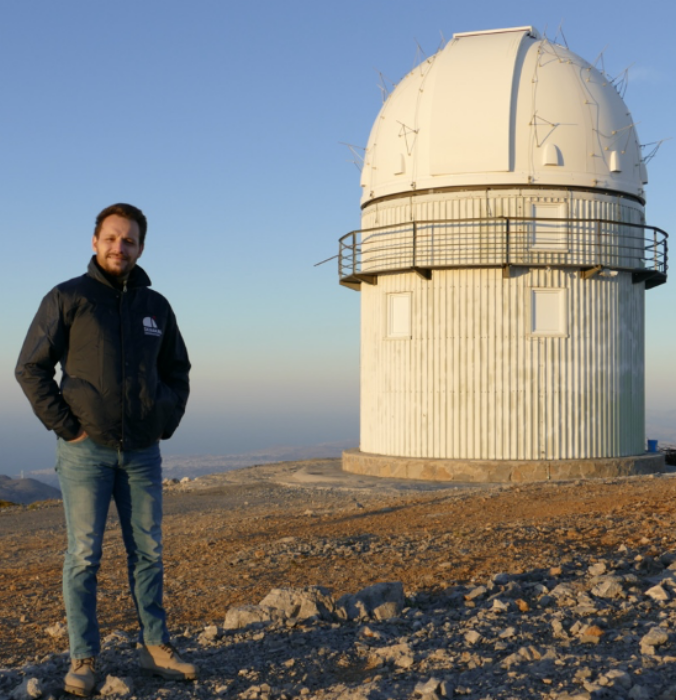|
pgc
|
Principal Catalogue of Galaxies number.
|
|
objname
|
Object name in the HyperLEDA.
|
|
id_ned
|
Name in NED.
|
|
id_nedd
|
Name in NED-Distance Catalogue.
|
|
id_iras
|
Name in IRAS-RBGS, or in RIFSCz if in the form Fxxxxx+xxxx.
|
|
id_2mass
|
ID in 2MASS-LGA, 2MASS-XSC, or 2MASS-PSC (see `flag_2mass`).
|
|
sdss_photid
|
SDSS photometric ID (consistent with DR8 releases and later).
|
|
sdss_specid
|
SDSS spectroscopic ID (consistent with DR8 releases and later).
|
|
ra
|
Decimal right ascension J2000.0 (degrees).
|
|
dec
|
Decimal declination J2000.0 (degrees).
|
|
f_astrom
|
Astrometric precision flag:
-1 for ~0.1 arcsec, 0 for 1 arcsec, 1 for 10 arcsec, etc.
|
|
r1
|
D25 semi-major axis (arcmin).
|
|
r2
|
D25 semi-minor axis (arcmin).
|
|
pa
|
D25 positional angle, North-to-Northeast (degrees).
|
|
rsource
|
Source of the galaxy-size information:
H=HyperLEDA, S=SDSS, 2=2MASS, 6=2dFGS, W=WINGS, Y=SkyMapper, A=Amiga-CIG, K=UNGC, V=VIII/77, 1=KKH2001, 7=KKH2007, N=NED.
|
|
rflag
|
Galaxy-size information flag:
0=missing, 1=all axes and positional angle defined, 2=r2 and/or pa were missing and they were set equal to r1 and 0 (circular isophote).
|
|
t
|
Numerical Hubble-type following the de Vaucouleurs et al. 1976 system.
|
|
e_t
|
Uncertainty on the numerical Hubble-type.
|
|
incl
|
Inclination (degrees).
|
|
v
|
Heliocentric radial velocity (km/s).
|
|
e_v
|
Uncertainty on the heliocentric radial velocity (km/s).
|
|
v_vir
|
Virgo-infall corrected radial velocity (km/s).
|
|
e_v_vir
|
Uncertainty on the Virgo-infall corrected radial velocity (km/s).
|
|
ndist
|
Number of redshift-independent measurements in NED-D used for the computation of the distance.
|
|
edist
|
If True, the NED-D distance measurements had uncertainties.
|
|
d
|
Distance (Mpc).
|
|
e_d
|
Uncertainty on the distance (Mpc).
|
|
d_lo68
|
Lower bound of the 68% confidence interval of the distance (Mpc).
|
|
d_hi68
|
Upper bound of the 68% confidence interval of the distance (Mpc).
|
|
d_lo95
|
Lower bound of the 95% confidence interval of the distance (Mpc).
|
|
d_hi95
|
Upper bound of the 95% confidence interval of the distance (Mpc).
|
|
dmethod
|
Method for the estimation of the distance:
N=using NED-D distance measurements,
Z=regression,
Zv=regression for Virgo Cluster members,
C=distance from NED-D measurements but uncertainty from regression, Cv=distance from NED-D measurements but uncertainty from Virgo Cluster regressor.
|
|
ut
|
Total U-band apparent magnitude (mag).
|
|
bt
|
Total B-band apparent magnitude (mag).
|
|
vt
|
Total V-band apparent magnitude (mag).
|
|
it
|
Total I-band apparent magnitude (mag).
|
|
e_ut
|
Uncertainty on the total U-band apparent magnitude (mag).
|
|
e_bt
|
Uncertainty on the total B-band apparent magnitude (mag).
|
|
e_vt
|
Uncertainty on the total V-band apparent magnitude (mag).
|
|
e_it
|
Uncertainty on the total I-band apparent magnitude (mag).
|
|
ag
|
Galactic absorption in B-band (mag).
|
|
ai
|
Intrinsic absorption in B-band (mag).
|
|
s12
|
12μm-band flux from IRAS (Jy)
|
|
s25
|
25μm-band flux from IRAS (Jy)
|
|
s60
|
60μm-band flux from IRAS (Jy)
|
|
s100
|
100μm-band flux from IRAS (Jy)
|
|
q12
|
Quality flag for the 12μm-band flux from IRAS (Jy):
0=not in IRAS, 1=upper limit, 2=moderate, 3=high, 4=flux from IRAS-RBGS.
|
|
q25
|
Quality flag for the 25μm-band flux from IRAS (Jy):
0=not in IRAS, 1=upper limit, 2=moderate, 3=high, 4=flux from IRAS-RBGS.
|
|
q60
|
0=not in IRAS, Quality flag for the 60μm-band flux from IRAS (Jy):
0=not in IRAS, 1=upper limit, 2=moderate, 3=high, 4=flux from IRAS-RBGS.
|
|
q100
|
Quality flag for the 100μm-band flux from IRAS (Jy):
0=not in IRAS, 1=upper limit, 2=moderate, 3=high, 4=flux from IRAS-RBGS.
|
|
wf1
|
3.3μm-band (W1) apparent magnitude in the WISE forced photometry catalog (mag).
|
|
wf2
|
4.6μm-band (W2) apparent magnitude in the WISE forced photometry catalog (mag).
|
|
wf3
|
12μm-band (W3) apparent magnitude in the WISE forced photometry catalog (mag).
|
|
wf4
|
22μm-band (W4) apparent magnitude in the WISE forced photometry catalog (mag).
|
|
e_wf1
|
Uncertainty on the 3.3μm-band (W1) apparent magnitude in the WISE forced photometry catalog (mag).
|
|
e_wf2
|
Uncertainty on the 4.6μm-band (W2) apparent magnitude in the WISE forced photometry catalog (mag).
|
|
e_wf3
|
Uncertainty on the 12μm-band (W3) apparent magnitude in the WISE forced photometry catalog (mag).
|
|
e_wf4
|
Uncertainty on the 22μm-band (W4) apparent magnitude in the WISE forced photometry catalog (mag).
|
|
wfpoint
|
True if point source in the WISE forced photometry catalog.
|
|
wftreat
|
True if treated as point source in the WISE forced photometry catalog.
|
|
j
|
J-band apparent magnitude in 2MASS (mag).
|
|
h
|
H-band apparent magnitude in 2MASS (mag).
|
|
k
|
J-band apparent magnitude in 2MASS (mag).
|
|
e_j
|
Uncertainty on the J-band apparent magnitude in 2MASS (mag).
|
|
e_h
|
Uncertainty on the H-band apparent magnitude in 2MASS (mag).
|
|
e_k
|
Uncertainty on the K-band apparent magnitude in 2MASS (mag).
|
|
flag_2mass
|
Source of the 2MASS ID and magnitudes:
0=none, 1=LGA, 2=XSC, 3=PSC.
|
|
u
|
u-band SDSS apparent magnitude (mag).
|
|
g
|
g-band SDSS apparent magnitude (mag).
|
|
r
|
r-band SDSS apparent magnitude (mag).
|
|
i
|
i-band SDSS apparent magnitude (mag).
|
|
z
|
z-band SDSS apparent magnitude (mag).
|
|
e_u
|
Uncertainty on the u-band SDSS apparent magnitude (mag).
|
|
e_g
|
Uncertainty on the g-band SDSS apparent magnitude (mag).
|
|
e_r
|
Uncertainty on the r-band SDSS apparent magnitude (mag).
|
|
e_i
|
Uncertainty on the i-band SDSS apparent magnitude (mag).
|
|
e_z
|
Uncertainty on the z-band SDSS apparent magnitude (mag).
|
|
logL_TIR
|
Decimal logarithm of the total-infrared (TIR) luminosity in solar luminosities (3.83x1033 erg/s)
|
|
logL_FIR
|
Decimal logarithm of the far-infrared (FIR) luminosity in solar luminosities.
|
|
logL_60μ
|
Decimal logarithm of the 60um-band luminosity in solar luminosities.
|
|
logL_12μ
|
Decimal logarithm of the 12um-band luminosity in solar luminosities.
|
|
logL_22μ
|
Decimal logarithm of the 22um-band luminosity in solar luminosities.
|
|
logL_K
|
Decimal logarithm of the K-band luminosity in solar luminosities.
|
|
ML_ratio
|
Mass-to-light ratio for the 2MASS K-band using SDSS g-r colour (Bell et al. 2003).
|
|
logSFR_TIR
|
Decimal logarithm of the TIR-based star-formation rate in solar masses per year.
|
|
logSFR_FIR
|
Decimal logarithm of the FIR-based star-formation rate in solar masses per year.
|
|
logSFR_60u
|
Decimal logarithm of the 60um-based star-formation rate in solar masses per year.
|
|
logSFR_12u
|
Decimal logarithm of the 12um-based star-formation rate in solar masses per year.
|
|
logSFR_22u
|
Decimal logarithm of the 22um-based star-formation rate in solar masses per year.
|
|
logSFR_HEC
|
Decimal logarithm of the homogenised star-formation rate in solar masses per year.
|
|
SFR_HEC_flag
|
Flag indicating the source of the photometry and the SFR indicator used in the homogenised SFR:
RT=IRAS-RBGS photometry and TIR indicator.
FT=RIFSCz photometry and TIR indicator.
FF=RIFSCz photometry and FIR indicator.
W3=WISE W3-band forced photometry and indicator.
W4=WISE W4-band forced photometry and indicator.
|
|
logM_HEC
|
Decimal logarithm of the total stellar mass in solar masses.
|
|
logSFR_GSW
|
Decimal logarithm of the SED-based star-formation rate from the GSWLC-2 in solar masses per year.
|
|
logM_GSW
|
Decimal logarithm of the SED-based stellar mass from the GSWLC-2 in solar masses.
|
|
min_snr
|
Minimum signal-to-noise ratio of the emission lines used for the activity classification (class_sp).
|
|
metal
|
12+log(O/H) gas-phase metallicity.
|
|
flag_metal
|
Metallicity flag:
-1=missing
0=reliable
1=O3N2 ratio >2 (outside the PP04 range)
2=low signal-to-noise ratio (<3 for the weakest line).
|
|
class_sp
|
Nuclear activity classification using the method in Stampoulis et al. 2019:
0=star-forming, 1=Seyfert, 2=LINER, 3=composite, -1=unknown.
|
|
agn_s17
|
AGN classification in She et al. 2017:
Y=AGN, N=non-AGN, ?=unknown
|
|
agn_hec
|
Adopted activity classification based on the combination of class_sp and
agn_s17: Y=AGN, N=non-AGN, ?=unknown
|















